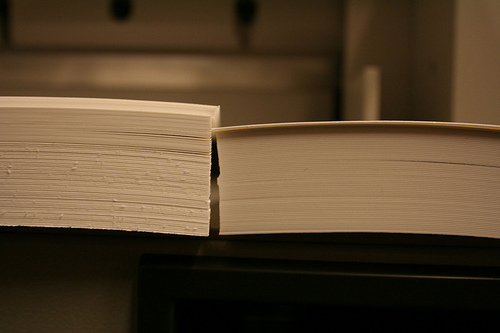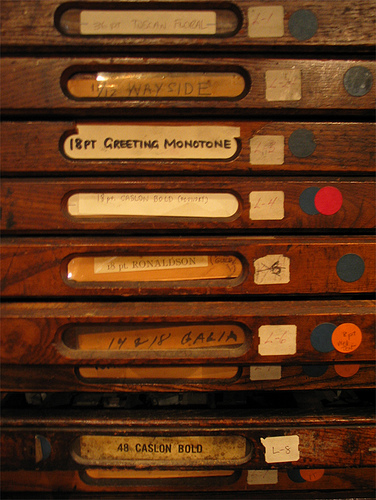I guess the cut is not the same on each side of a guillotine blade, because it is bevelled on one side and flat on the other. I like glimpses of the details of other people’s areas of expertise.
Tag: beauty
Names for typefaces
Greeting Monotone is no Godbold but I’ll take it. I fetishize type cases too much.
Look good naked, bring your own analysis, a lot of video links.
A bloggy friend of Erin’s posted about a TV show called How To Look Good Naked. I don’t have cable, and I didn’t know anything about this show. This blogger, Sarah, said the show basically relied on body image coaching to help women like their nude bodies, with no weight loss or surgery suggestions at all. I found this improbably thrilling news regarding a reality makeover show, so I looked it up on YouTube. This is from the American version (the original is British).
They just pointed out that plastic surgery doesn’t work? On TV? And they used their feelings to decide how to solve their personal distress? Yay hooray! The clips I found raise a ton problems for me, but wow, I am really happy to see this conversation happening on a mainstream makeover show.
Problems/boring parts:
- That blond mom clearly spends a lot of time grooming and performing “being pretty.”
- The show stars a man as the expert despite being about women’s body image.
- It’s safe to have this man see you in your underwear because he’s gay, but I don’t see anyone pointing out how that makes straight men’s expected behaviour quite obviously problematic. (Also in that clip, host Carsen casually equates strippers and low-class names, managing to bash both at once. There are other ways to make that joke, sir.)
- It focusses on a lot of external validation (mirrors, man host’s perspective, other people’s compliments).
- The show values looking conventionally femme and ‘sexy’ over feeling comfortable (external validation again).
- They have a half-assed acceptance of fat (don’t hide your fat… because that will make you look fatter).
- It demonstrates the conventionally feminine ambigious ‘no’ (giggle giggle smile) and seems to believe that coerced nudity is ok if one person really thinks it’s for the best.
- Obviously the producers just realized that “real beauty” will attract a valuable target demographic (thanks for that, Dove).
- Based only on these clips, they don’t seem to point out that your body has any endearing qualities besides the way it looks.
- The host looks like he’s had some work done himself.
And yet, I am still definitely pleased to see a rounded woman’s butt cellulite on screen in a positive context, hear someone make the basic point that clothes need to fit your body and not vice versa, and even see men touching each other fairly comfortably.
This is a very narrow discussion of body image, but it is at least in a direction that I value: unpacking all the crap that people said you should do and deciding for yourself. (My body and I are totally bff almost all the time anyway, so I’m not disappointed about the lack of new ground.)
It’s quite the comment on the state of TV that eliminating weight loss and surgery without discussing anything else is cause for celebration, but maybe these baby steps will make some room for a similar show that adds a couple of elements, and then a couple more. No weight loss, no surgery, and no dissing fat. Or getting to know your body without looking at it. Queer eye for the straight girl, finally, or a show where women come up with ways to enjoy their bodies without a host/star/authority at all. I dream.
7 wrens, sets of sets
I was thinking about sets of sets when I came across this set of similar wrens, discussing the collections of identifying marks that make up a distinguishable bird species.
The same site has a lovely little discussion of preparing the mind to see birds.
Experts say that when we lose something, before we begin our search to find the lost thing we should picture the object in our minds. This kind of “visualization” causes the brain to do something wonderful. On the one hand, it appears to filter out many unnecessary sightings but, on the other, if something even remotely resembling the lost object comes into view, the mind seems to “jump” at it.
Power of pattern matching.
Sets of sets, letters with warping

Repetition with variation along two dimensions: different Rs, warped to different degrees.
Curling, graininess suitably expressing surreality.

I went curling after hours at a rink owned by some friends of my cousin, out near Sidney.
- It was surprisingly fun, in the way that bocci, billiards and croquet are fun. Minimally-confrontational exercises in physics.
- So far I’ve never once been a fan of flattening large areas of land (parking lots, malls, golf courses…), especially land where I understand something about it having been colonized and occupied. It’s extra absurd when the flattening is done for sports. Non-cooperation overload.
- If I were actually into playing sports, I would set up a beautiful place to play for once. Rinks, fields, courses and courts are all so ugly! Wow. I wonder if spending time in artificially lit, flattened out, weirdly-proportioned, echo-y, energy sinkhole type spaces might be damaging on its own, even without the formalized competition and violence and the addiction to contrived adrenaline rushes. (Hi, I have fun ideas about sports!) Certainly people say that about office cubicles, that the ugliness is demoralizing, even without the bureaucratic hierarchy crap.
- And, curling was really fun. Pushing heavy things across ice with measurement marks is basically sensory play. Balance, momentum, angles, stretching, muscles. I bet curling kink parties would be fun.
Monster love, my favourite.
a skinny older man body
When I saw the Century Project (a man took nude photos of women from ages 0-100), my first thought was to wonder whether anybody was making a similar collection of naked men. I think there is more of a lack of images of naked men overall. So I collected this one a few months ago, and that’s as far as I got.
Armpit appreciation moment.
To go with the armpit-appreciation photo I posted before… I seem to be collecting these a little bit.
Mastectomy scars, many breasts
This topless group portrait including one woman with double mastectomy scars is strangely sweet. They look like they’re having a good time, with their huge pants from 1996 and their various breast shapes.
Eyes, loops, symmetry, quote
Burn scars, perception, beauty
In 2001 I met a burn survivor who allowed me to photograph her. She told me that she wanted to be photographed so that people could stare at her without feeling embarrassed. It was such an extraordinary experience that a few months later I flew to a burn conference and set up a makeshift studio in a hotel room, and asked people to let me know if they would like their portraits made. I was astonished at how many people did. What I learned from this extraordinary experience was that every burn survivor has a tale of courage to tell, and that the burns have their own eerie beauty. I also learned that after a few hours it becomes very difficult to see the burns anymore. When I returned and developed the photographs, I had to keep asking my wife “does this person look burned to you?”, because they all looked quite normal to me. My only regret is that I didn’t continue with this project longer than I did, but life intervened.
I love love love the possibility of not being able to tell who is scarred and who isn’t. Eye of the beholder.





